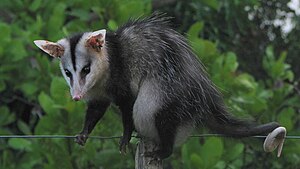Common white oropossum
| Common white oropossum | ||||||||||||
|---|---|---|---|---|---|---|---|---|---|---|---|---|

Common white oropossum ( Didelphis albiventris ) |
||||||||||||
| Systematics | ||||||||||||
|
||||||||||||
| Scientific name | ||||||||||||
| Didelphis albiventris | ||||||||||||
| Lund , 1840 |
The common white oropossum ( Didelphis albiventris ) is a marsupial in the opossum family that is found in South America.
features
The species has a very variable body size with a head body length of 26 to 50 cm, a tail length of 25.5 to 53.5 cm and a weight of 0.5 to 5.5 kg. Depending on the source, the average length of the hind feet is given as 4.8 or 5.9 cm, while the values for the ears are 5.0 or 5.4 cm. As with the southern opossum, there are different colors in the fur of the body. The most obvious difference, the white ears in adult specimens, is reflected in the German name. In addition, the first centimeters of the tail of the common white opossum are covered with fur, while the southern opossum only has a few hairs. There is a V-shaped black pattern on the face from the area between the eyes to the top of the head and two dark eye stripes. The tip of the tail is colored white.
distribution
The distribution area of the common white oropossum extends from central areas of Brazil and Bolivia via Paraguay and Uruguay to the central areas of Argentina . The species can be found in almost all habitats in the range, whereby only high mountain locations, very dry areas and the densest forests are avoided. The common white oropossum can adapt well to changes in the landscape.
Way of life
The species mostly hangs out on the ground, although it can climb trees well. It feeds on worms, insects, smaller birds, eggs and fruits, among other things. The average area of males is 3.2 hectares with a maximum area size of 7.04 hectares. The territories of females are smaller with an average of 1.47 hectares.
One or two litters can occur in northern Argentina between August and January. The number of offspring per litter varies between four and twelve. The birth takes place after 12 to 13 days of gestation . Then the young animals live in their mother's pouch for about two months. Older young animals can be carried on their backs by the female.
Man and common white oropossum
Farmers have an ambivalent relationship with this marsupial. On the one hand, the opossum can cause damage when it eats useful birds or cultivated fruits. On the other hand, pests such as rodents or insects are among its prey.
Several animals are caught for their fur, which is processed in the fur industry . In the years 1974 to 1978 that affected 700,000 copies. However, the IUCN does not consider this form of use to be worth mentioning.
There are no hazards for the common white ophropossum. Since it can adapt well to changes, it is listed as not at risk (least concern) .
supporting documents
- ^ Didelphis albiventris . In: Don E. Wilson , DeeAnn M. Reeder (Eds.): Mammal Species of the World. A taxonomic and geographic Reference. 2 volumes. 3. Edition. Johns Hopkins University Press, Baltimore MD 2005, ISBN 0-8018-8221-4 .
- ^ A b c d Eisenberg & Redford: Mammals of the Neotropics . tape 3 . University of Chicago Press, 1999, pp. 52-53 ( Didelphis albiventris ).
- ↑ a b c d Mares, Ojeda & Barquez: Guide to the Mammals of Salta Province, Argentina . University of Oklahoma Press, 2015, pp. 34-36 ( Didelphis albiventris ).
- ↑ a b c d e Didelphis albiventris in the endangered species Red List of IUCN 2017. Submitted By: Costa, LP, Astua de Moraes, D., Brito, D., Soriano, P. & Lew, D., 2015. Retrieved on February 19, 2018.
